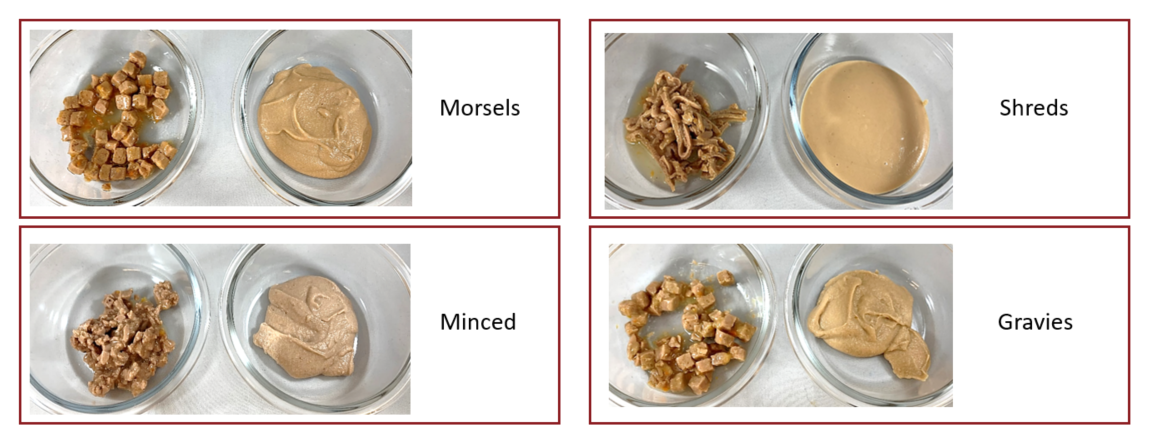Cat pet parents, for example, note their cats are inclined to lick the gravy and refuse the chunks in chunks and gravy meals, which suggests to pet parents the chunks are less enjoyable.
Research at AFB International includes creative methods to measure palatability preference in cats and dogs for various food types, including those with multiple shapes and textures. Eating enjoyment is a dimension of palatability and can be interpreted by the pet's interaction with the food, and/or by what pet parents perceive as they watch their pet eat.
In a recent study, we measured multiple responses during cats' interactions with food and summarized them as Initial Attraction (First Approached, First Tasted, Duration of First Eating Bout) and Sustained Interest (Consumption, Uptake, Food Focus) to evaluate how individual food components of a chunks and gravy meal influence eating enjoyment. We found that cats indeed preferred gravy to other components of the meal, which supports many pet parent perceptions. Additionally, chunks were avoided in favor of anything with gravy, and when chunks alone were offered versus the whole chunks and gravy meal cats primarily licked the gravy from the chunks and gravy meal.
STUDY 1
Hypotheses: a) gravy alone would be preferred over chunks and gravy and over chunks alone, and b) chunks and gravy would be preferred over chunks alone. Supported.

Figure 1. Components of a highly palatable commercial wet food presented in two-bowl trials.

Table 1. Results for the most enjoyed food component by cats in 2-bowl trials. Anything with gravy was preferred by cats.
Based on the outcome of this study, we again measured cats' interactions with foods (i.e., Initial Attraction and Sustained Interest) evaluating whether they prefer to lick rather than chew their meals. To do this we blended chunks and gravy meals in a food processor to achieve a homogenous, lick-able whole meal and offered it versus the original form of food. Specific responses within Sustained Interest indicated that the blended form of the meal was consumed more than the original form, likely because it was more efficient to consume. However, collectively, the additional measures suggested that cats enjoyed the original forms more than the blended forms.
Marketplace
STUDY 2
Hypothesis: Cats prefer to lick rather than chew their chunks and gravy meals. Not supported.

Figure 2. Blended and original (unblended) forms of four commercial products presented in two-bowl trials.

Table 2. Results for Eating Enjoyment in cats of blended and original forms of wet foods in two-bowl trials. In general, original forms were enjoyed more than blended forms.
Measures of eating enjoyment offer additional insight to the feeding experience of cats and dogs by describing how they are eating not just how much they eat. Here, Initial Attraction and Sustained Interest demonstrated that cats enjoy a specific component of a whole meal over other components. Unexpectedly these enjoyment measures also revealed more about our cats' eating experience: licking, although efficient, is not the primary driver of enjoyment of a wet meal.
Finally, we continuously seek to gain a better understanding of eating enjoyment as a dimension of palatability that helps to guide product improvements that ultimately provide a more satisfying eating experience for cats and their people. These methods can be applied to investigate palatability of many food matrices, such as heterogenous wet and dry foods, as well as their corresponding size, form, and texture.
By: AFB International - Research and Development
You could be interested: Delayed Dry Palatant Coating: Does it Affect Palatant Recovery Rate and Palatability?
About company

About company
WHAT WE DO
At AFB International, we develop and produce a full range of liquid and dry palatability enhancers. We use high-quality ingredients proven to optimize companion animal response and consumption.
Our specialty? Meeting your unique needs with custom support. Our worldwide staff of technical experts is ready to assist you with all aspects of palatability enhancement, from product development and testing to processing, logistics and more.
HOW WE WORK
Our successful customer relationships are built on clear, consistent communication—starting with really listening to understand your needs so we can respond quickly and effectively. And we keep listening. AFB scientists and technical service managers routinely travel to customer facilities to clearly understand the challenges at hand and the systems in place. Then we can recommend the best viable solutions.
OUR TEAM
AFB is dedicated to improving the health and wellness of companion animals worldwide through superior products and services. Our diverse, committed team works collaboratively to serve our clients. Get to know us—and let us know how we can help you!
HISTORY
AFB launched in 1986 and has grown to be the global science and technology leader in pet food palatability. Headquartered in St. Charles, Missouri, USA, AFB is a global company with state-of-the-art facilities in the United States, Argentina, Brazil, Mexico, the Netherlands, China, and Australia. AFB is a wholly owned subsidiary of Ensign-Bickford Industries, Inc., a privately held, family-owned, professionally managed technical business that traces its roots back more than 185 years.











































